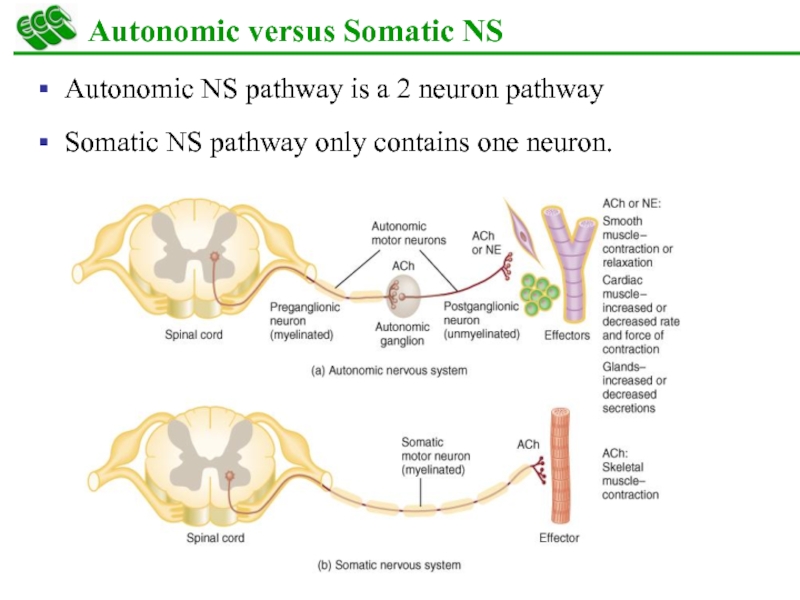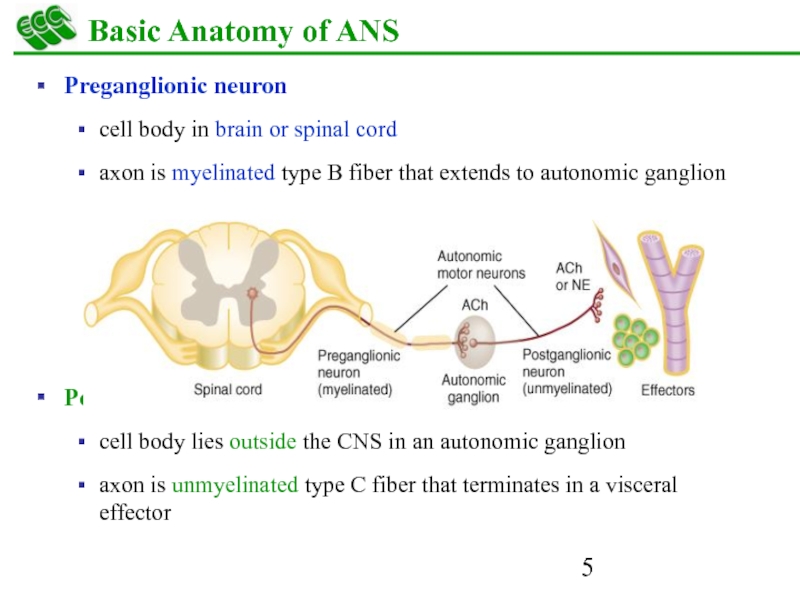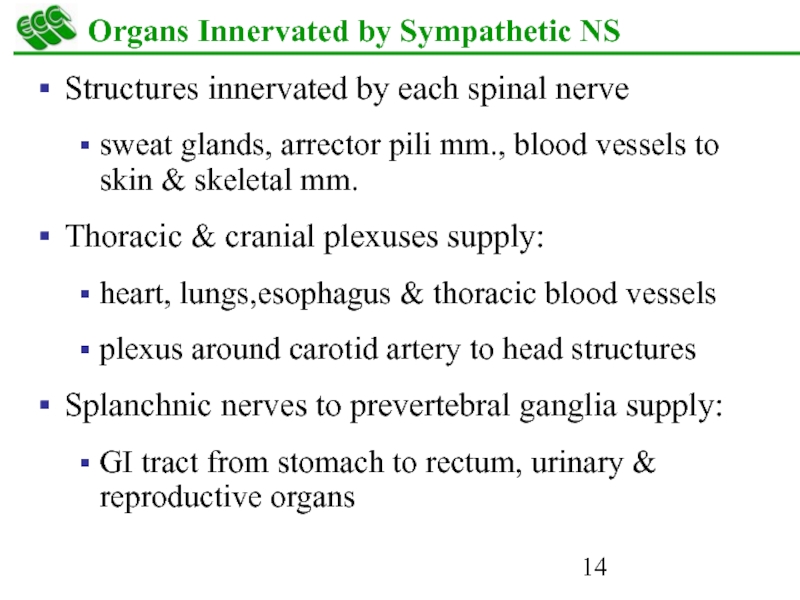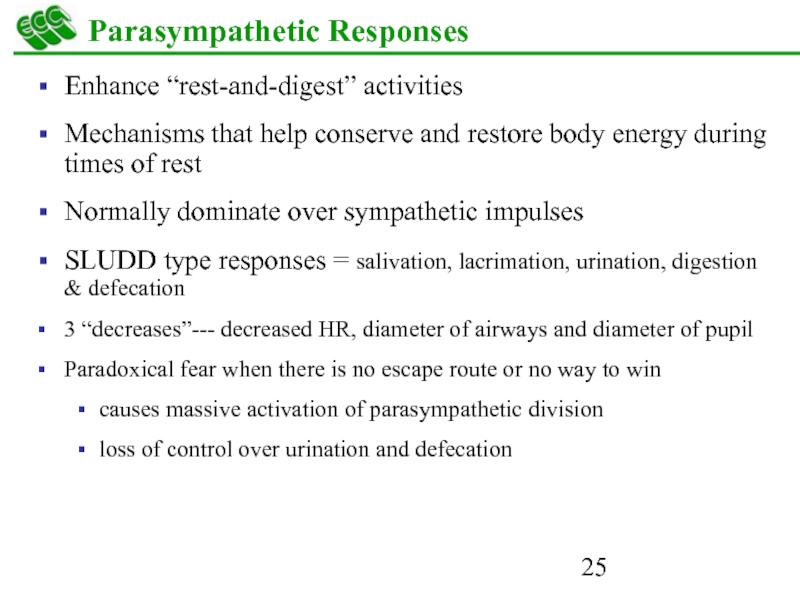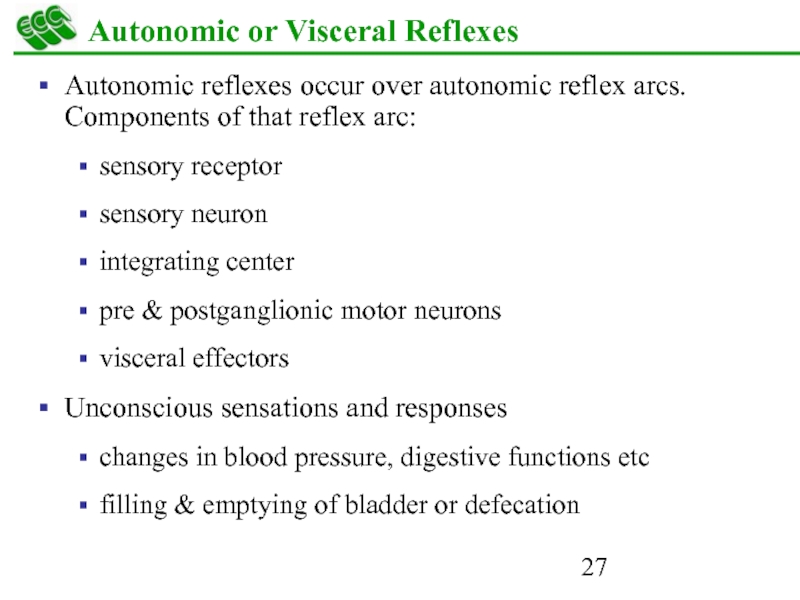Слайд 1Autonomic Nervous System
Overview
Anatomy
Physiology
Слайд 2The Autonomic Nervous System
Regulate activity of smooth muscle, cardiac muscle
& certain glands
Structures involved
general visceral afferent neurons
general visceral efferent neurons
integration
center within the brain
Receives input from limbic system and other regions of the cerebrum
Слайд 3Autonomic versus Somatic NS
Somatic nervous system
consciously perceived sensations
excitation of skeletal
muscle
one neuron connects CNS to organ
Autonomic nervous system
unconsciously perceived visceral
sensations
involuntary inhibition or excitation of smooth muscle, cardiac muscle or glandular secretion
two neurons needed to connect CNS to organ
preganglionic and postganglionic neurons
Слайд 4Autonomic versus Somatic NS
Autonomic NS pathway is a 2 neuron
pathway
Somatic NS pathway only contains one neuron.
Слайд 5Basic Anatomy of ANS
Preganglionic neuron
cell body in brain or spinal
cord
axon is myelinated type B fiber that extends to
autonomic ganglion
Postganglionic neuron
cell body lies outside the CNS in an autonomic ganglion
axon is unmyelinated type C fiber that terminates in a visceral effector
Слайд 6Divisions of the ANS
2 major divisions
parasympathetic
sympathetic
Dual innervation
one speeds up organ
one
slows down organ
Sympathetic NS increases heart rate
Parasympathetic NS decreases heart
rate
Слайд 7Autonomic Nervous System
Overview
Anatomy
Neurotransmitter
Physiology
Слайд 8Sources of Dual Innervation
Sympathetic (thoracolumbar) division
preganglionic cell bodies in thoracic
and first 2 lumbar segments of spinal cord
Parasympathetic (craniosacral) division
preganglionic
cell bodies in nuclei of 4 cranial nerves and the sacral spinal cord
Слайд 9Locations of Autonomic Ganglia
Sympathetic Ganglia
trunk (chain) ganglia near vertebral bodies
prevertebral
ganglia near large blood vessel in gut
celiac
superior mesenteric
inferior mesenteric
Parasympathetic
Ganglia
terminal ganglia in wall of organ
Слайд 10Autonomic Plexuses
Cardiac plexus
Pulmonary plexus
Celiac (solar) plexus
Superior mesenteric
Inferior mesenteric
Hypogastric
Слайд 11Structures of Sympathetic NS
Preganglionic cell bodies at T1 to L2
Rami
communicantes
white ramus = myelinated = preganglionic fibers
gray ramus = unmyelinated
= postganglionic fibers
Postganglionic cell bodies
sympathetic chain ganglia along the spinal column
prevertebral ganglia at a distance from spinal cord
celiac ganglion
superior mesenteric ganglion
inferior mesenteric ganglion
Слайд 12Ganglia & Plexuses of Sympathetic NS
Слайд 13Pathways of Sympathetic Fibers
Spinal nerve route
out same level
Sympathetic chain route
up
chain & out spinal n
Collateral ganglion route
out splanchnic n to
collateral ganglion
Слайд 14Organs Innervated by Sympathetic NS
Structures innervated by each spinal nerve
sweat
glands, arrector pili mm., blood vessels to skin & skeletal
mm.
Thoracic & cranial plexuses supply:
heart, lungs,esophagus & thoracic blood vessels
plexus around carotid artery to head structures
Splanchnic nerves to prevertebral ganglia supply:
GI tract from stomach to rectum, urinary & reproductive organs
Слайд 15Circuitry of Sympathetic NS
Divergence = each preganglionic cell synapses on
many postganglionic cells
Mass activation due to divergence
multiple target organs
fight or
flight response explained
Adrenal gland
modified cluster of postganglionic cell bodies that release epinephrine & norepinephrine into blood
Слайд 16Anatomy of Parasympathetic NS
Preganglionic cell bodies found in
4 cranial
nerve nuclei in brainstem
S2 to S4 spinal cord
Postganglionic
cell bodies very near or in the wall of the target organ in a terminal ganglia
Слайд 17Parasympathetic Cranial Nerves
Oculomotor nerve
ciliary ganglion in orbit
ciliary muscle & pupillary
constrictor muscle inside eyeball
Facial nerve
pterygopalatine and submandibular ganglions
supply tears, salivary
& nasal secretions
Glossopharyngeal
otic ganglion supplies parotid salivary gland
Vagus nerve
many brs supply heart, pulmonary and GI tract as far as the midpoint of the colon
Слайд 18Parasympathetic Sacral Nerve Fibers
Form pelvic splanchnic nerves
Preganglionic fibers end
on terminal ganglia in walls of target organs
Innervate smooth muscle
and glands in colon, ureters, bladder & reproductive organs
Слайд 19ANS Neurotransmitters
Classified as either cholinergic or adrenergic neurons based upon
the neurotransmitter released
Adrenergic
Cholinergic
Слайд 20Parasympathetic
Cholinergic neurons release acetylcholine from preganglionic neurons & from parasympathetic
postganglionic neurons
Action: Excites or inhibits depending upon receptor type and
organ involved
Receptor:
Nicotinic receptors are found on dendrites & cell bodies of autonomic NS cells and at NMJ
Muscarinic receptors are found on plasma membranes of all parasympathetic effectors
Слайд 21Sympathetic
Adrenergic neurons release norepinephrine (NE) from postganglionic sympathetic neurons only
Action:
Excites or inhibits organs depending on receptors
Receptor:
Alpha1 and Beta1 receptors
produce excitation
Alpha2 and Beta2 receptors cause inhibition
Beta3 receptors (brown fat) increase thermogenesis
NE lingers at the synapse until enzymatically inactivated by monoamine oxidase (MAO) or catechol-O-methyltransferase (COMT)
Слайд 22Autonomic Nervous System
Overview
Anatomy
Physiology
Hypothalamus
Sympathetic
Parasympathetic
Слайд 23Physiological Effects of the ANS
Hypothalamus
Some organs have only sympathetic innervation
sweat
glands, adrenal medulla, arrector pili mm & many blood vessels
controlled by regulation of the “tone” of the sympathetic system
Most body organs receive dual innervation
innervation by both sympathetic & parasympathetic
Hypothalamus regulates balance (tone) between sympathetic and parasympathetic activity levels
Слайд 24Sympathetic Responses
Dominance by the sympathetic system is caused by physical
or emotional stress -- “E situations”
emergency, embarrassment, excitement, exercise
Alarm
reaction = flight or fight response
dilation of pupils
increase of heart rate, force of contraction & BP
decrease in blood flow to nonessential organs
increase in blood flow to skeletal & cardiac muscle
airways dilate & respiratory rate increases
blood glucose level increase
Long lasting due to lingering of NE in synaptic gap and release of norepinephrine by the adrenal gland
Слайд 25Parasympathetic Responses
Enhance “rest-and-digest” activities
Mechanisms that help conserve and restore body
energy during times of rest
Normally dominate over sympathetic impulses
SLUDD type
responses = salivation, lacrimation, urination, digestion & defecation
3 “decreases”--- decreased HR, diameter of airways and diameter of pupil
Paradoxical fear when there is no escape route or no way to win
causes massive activation of parasympathetic division
loss of control over urination and defecation
Слайд 26Comparison
CVS: Heart
CVS: Veins
Resp: Bronchioles
GIT: Stomach
and Intestines
GIT: Liver
GIT: Gall
Bladder
UT: Kidney
UT: Urinary Bladder
Repro: Sex Organs
Sympathetic
Increase HR
Constriction
Dilation
Ejaculation
Parasympathetic
Increase motility
Glycogenesis
Contraction
Diuresis
Contraction/ urination
Erection
Repro: Sex
Organs
Слайд 27Autonomic or Visceral Reflexes
Autonomic reflexes occur over autonomic reflex arcs.
Components of that reflex arc:
sensory receptor
sensory neuron
integrating center
pre & postganglionic
motor neurons
visceral effectors
Unconscious sensations and responses
changes in blood pressure, digestive functions etc
filling & emptying of bladder or defecation
Слайд 28Control of Autonomic NS
Not aware of autonomic responses because control
center is in lower regions of the brain
Hypothalamus is major
control center
input: emotions and visceral sensory information
smell, taste, temperature, osmolarity of blood, etc
output: to nuclei in brainstem and spinal cord
posterior & lateral portions control sympathetic NS
increase heart rate, inhibition GI tract, increase temperature
anterior & medial portions control parasympathetic NS
decrease in heart rate, lower blood pressure, increased GI tract secretion and mobility
Слайд 29Autonomic Dysreflexia
Exaggerated response of sympathetic NS in cases of spinal
cord injury above T6
Certain sensory impulses trigger mass stimulation of
sympathetic nerves below the injury
Result
vasoconstriction which elevates blood pressure
parasympathetic NS tries to compensate by slowing heart rate & dilating blood vessels above the injury
pounding headaches, sweating warm skin above the injury and cool dry skin below
can cause seizures, strokes & heart attacka



